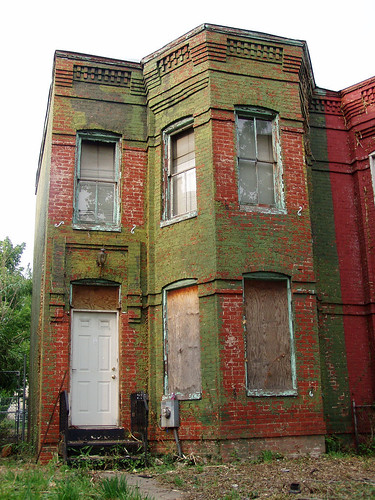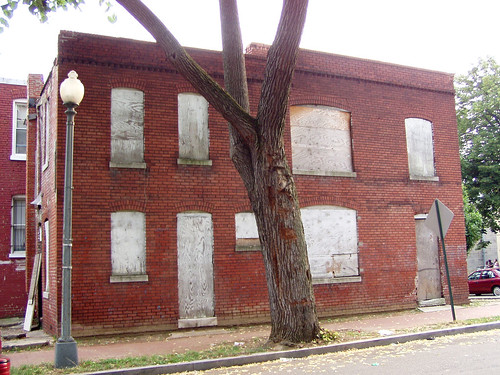Housing receivership to cure nuisance properties: the option that DC refuses to consider
 Vacant rowhouse in the Trinidad neighborhood of DC, photographed sometime before February 2006 by Frozen Tropics.
Vacant rowhouse in the Trinidad neighborhood of DC, photographed sometime before February 2006 by Frozen Tropics.In 2002, I went to the National Trust for Historic Preservation conference, which was then in Cleveland, and I was exposed on a bunch of tours to the neighborhood stabilization efforts of the Cleveland Restoration Society and the Famikos Foundation.
Because Cleveland was and is a shrinking city, with minimal appreciation in housing prices, restoring historic properties doesn't came back in improved housing values the way it does in a strong market neighborhood in Brooklyn, or DC, or Alexandria, Virginia, or certain neighborhoods in Boston, etc.
In weak market cities the priority is neighborhood stabilization. So often these organizations--at least back then, complemented by other city and county programs--would get control of properties and stabilize and improve them, often to the point beyond the amount a house could sell for in that market, in order to save the house and improve the neighborhood.
 Building at right at 2nd and T Street NE, around 2006.
Building at right at 2nd and T Street NE, around 2006.I looked into this further and discovered that these efforts were aided by a strong State of Ohio statute providing for the ability to establish receivership for properties and a separate "Housing Court," to address housing-related matters.
Receivership can be awarded in order to cure habitual nuisances, and the Housing Court had the ability to award title for properties in receivership--provided that the nuisance was cured. (DC nonprofits and the city have a bad habit of getting control of properties and then doing nothing with them for many years. In such a situation, these entities ought not to be deemed "fit" to be able to be awarded properties through the receivership process.)
I was impressed and from 2002 to 2006, I used to testify about this before various DC City Council committees. See "Receivership for housing" for part of the written testimony. Eventually I stopped because there was no werewithal to take this concept up and apply it within DC.
The City Paper has a piece, "Lost and Foundering," about long term vacant properties in DC, and how the primary method that the city uses to get them back on the market--from the article:
D.C. has a system that’s supposed to prevent vacant and blighted properties from staying this way. If the Department of Consumer and Regulatory Affairs finds a property to be vacant, the agency slaps it with a 5-percent property tax; if it’s vacant and blighted, it becomes a 10 percent tax, a steep increase from the standard .85 percent rate for residential property. Generally, that charge is enough incentive for the property owner to fix up the building or sell it.
But what happens if the city can’t find the owner? When I visit 430 Manor Place, there’s a stapled packet of D.C. Superior Court documents taped to the front doorstep—Boese says these packets appear there periodically—detailing a lawsuit against the house’s owner, listed as “Estate of Irby L. Dickinson (a/k/a Irby Dickenson a/k/a Irby Dickson)” and “Unknown Heirs of Irby Dickinson,” both with an address in Birmingham, Ala. City property records show that “Irby Dickenson” bought the Manor Place property in 1945, though there’s also mention of an “Alma Dickinson” in 1968 and an “Irby Dickerson” in 1999, when the city put a lien on the house.
 Left: another vacant property in the Trinidad neighborhood, photo by Frozen Tropics.
Left: another vacant property in the Trinidad neighborhood, photo by Frozen Tropics.The primary method is to have a big tax on vacant property. That does encourage sale to presumably better owners, but at the same time, it can encourage demolition, see "D.C. buildings linked to Armenian Genocide museum to be razed" from the Washington Business Journal, as an example. Generally this is not in the public interest, but is done to reduce taxes. (Something similar happened in the H Street neighborhood, with buildings next to the Atlas Theater. The property owner got permission to demolish the buildings, which would have been contributing structures in a historic district, but H Street is not designated. But the rise in value of the properties encouraged the owner to sell to a property owner disposed to take care of the property instead.)
 Right: this building on H Street has been up for lease for at least ten years. One way to get around the vacant property tax is to slap up a for lease sign, even if you are asking way to much money to lease the building and it requires thousands of dollars in renovation costs, which the property owner is not willing to pay.
Right: this building on H Street has been up for lease for at least ten years. One way to get around the vacant property tax is to slap up a for lease sign, even if you are asking way to much money to lease the building and it requires thousands of dollars in renovation costs, which the property owner is not willing to pay.The secondary method is to move on a property in Condemnation Court. Again, this will motivate some property owners to sell, but others will just demolish the property, which may have been their intent all along. See "Dwelling in the Past: Larry Quillian wants to raze his shotgun shack" from the City Paper. I think of a building demolished on 10th Street NE around 2002, in response to a "condemnation notice". The lot is still vacant today and if they had just fixed up the property, today it would be worth in excess of $600,000. This is not in the public interest either.
The third method would be to have a method to establish receivership for properties that are determined to be nuisances, just like in the State of Ohio. That DC doesn't do.
Hence, the problem of having properties stay vacant, often for decades, or buildings that should be preserved, getting demolished, and the creation of new nuisances--vacant lots--that are just as hard to "fix".
--------
Also see the past blog entries, "Investment vs. Disinvestment," which discusses in part what I call "the language of revitalization" and "Preservation Laws do matter," which discusses the necessity of having the right laws and remedies in place, in order to address demolition by neglect and other neighborhood stabilization issues.
-- and the book Bringing Buildings Back by Alan Mallach, see "Bringing buildings back is really about bringing urban neighborhoods back "
-- while focused on weak markets, the Center for Community Progress focuses on vacant property issues, including receivership.
-- Their annual conference on Reclaiming Vacant Properties is September 9th-11th in Philadelphia.
-- Also see the Washington Post story, "Manassas's 9300 Prescott Ave. home sees likely resolution to weary story," about a house that has been vacant for decades, and the inability of the locality to address the situation for many years, and how neighbors came together to buy the house in order to "cure" the nuisance.
Labels: historic preservation, housing, nuisance properties, property tax assessment methodologies, real estate development, receivership, vacant properties



2 Comments:
this is important
Is there an agency that handles occupied nuisance properties? Unfortunately calling 7D to handle the apartments on 22nd and Savannah SE is absolutely useless. The residence of Oxon Creek has begged and pleaded with 7D and William C. Smith to control the violence and illegal activity for years. Yet we are still coming home to gunfire, gang activity and drug dealing. There is not one Townhome that backs to 22nd Street that doesn't have bullet holes. We personally came home to a bullets in bed and bedroom walls. We slept in the guest room until the summer was over. However just this past Sunday at approximately 10am multiple shots were fired on 22nd. We the residents of Oxon Creek Townhome feel so helpless. We pay our taxes so that a low-income property can bring fear to us each and everyday. What can be when William C Smith turn their heads as the collect government checks. It is only time that a bullet meant for a person on 22nd finds it way to a resident of Oxon Creek Townhome. I only pray it's not a child. Since many that purchased our townhome 12 years ago now have a families. Any advise is welcome.
Post a Comment
<< Home